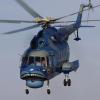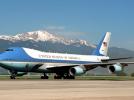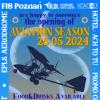ANZ B733 at Christchurch on Oct 29th 2011, descended below decision height without visual reference
An ANZ Air New Zealand Boeing 737-300, registration ZK-NGH performing flight NZ-501 from Auckland to Christchurch (New Zealand) with 128 passengers and 6 crew, departed Auckland with a captain (68, ATPL, 23,875 hours total, 7,210 hours on type), a first officer (43, ATPL, 8,420 hours total, 2,320 hours on type) and a check captain (49, ATPL, 17,200 hours total, 9,200 hours on type) in the observer seat conducting the annual route check on the captain. The captain was pilot flying for the sector. The weather forecast for Christchurch indicated to expect broken cloud ceiling at 1200 feet, rain, visibility of 1500 meters reducing to 200 meters in rain.
Following an uneventful departure, cruise and descent towards Christchurch, ATIS reporting overcast cloud at 300 feet, runway wet, winds from 020 degrees at 6 knots, visibility of 6000 meters reducing to 2000 meters, the aircraft intercepted the localizer runway 02 for an ILS Category I approach (decision height at 200 feet, required minimum visibility 800 meters). Using the autopilot the captain descended the aircraft on the glideslope, at decision height the aircraft was still in cloud and the runway or approach lights were not visible. The captain however did not initiate a go-around. Just when first officer and check captain were about to intervene, the approach lights became visible at about 100 feet AGL and the captain continued for a safe landing on runway 02.
New Zealand's TAIC released their final report concluding the probable causes of the incident were:
- The captain did not make the appropriate response to two automated calls prior to the aeroplane reaching the point (decision height) at which the flight crew needed to decide whether to continue and land, or initiate a missed approach, and the first officer did not challenge the captain for an appropriate response on either occasion.
- The captain compromised the safety of the flight by not initiating a missed approach when the aeroplane reached the decision height and the meteorological conditions were not suitable to land.
- The only appropriate decision was for the captain to commence a missed approach. He did not make that decision probably because he was operating under a level of stress, where anxiety was interfering with his cognitive functioning
- There was no evidence to suggest that the pilot’s age was a factor affecting his performance on the flight.
- The presence of the check captain on the flight deck and its effect on crew dynamics and communications had not been thoroughly discussed during the pre-flight briefing, which had the potential to blur the boundaries of individual involvement in the flight deck operations.
- The operator had not followed its own procedures for managing the previously identified performance issues with the captain. This resulted in his continuing with non-conforming practices, virtually unchallenged.
The TAIC analysed: "When an aeroplane is on an instrument approach to a runway, it is a serious safety issue when the pilot continues with the descent below the minimum (decision) height without having the required visual references. Decision heights are calculated with safety margins to allow specific aircraft types to initiate safe missed approaches in the event of runway lights or markings not becoming visible. If a decision height is not heeded, safety margins are rapidly eroded and there is a real risk of the aeroplane landing with enough force to damage the landing gear. The consequences could be worse if the aeroplane were not aligned correctly with the runway at the time."
The TAIC analysed that the operators standard operating procedures required a managed approach in instrument meteorological conditions with the captain always being pilot flying, making the decisions and acquiring the visual cues to continue for landing, while the first officer as pilot monitoring would monitor the instruments and call any deviation from expected values. From 1500 feet AGL downwards the first officer would thus be "heads down". The TAIC quoted: "This maximises the chances of obtaining the required visual cues at decision altitude."
The TAIC reported that the aircraft was descending through 1000 feet AGL and the radar altimeter made the automated call one thousand, the captain was supposed to acknowledge the call by stating whether the approach was stable or not, however the captain did not make the call, nor did the first officer challenge the captain. The TAIC stated: "The check captain believed he heard the captain “grunt”. Both [first officer and check captain] later said that the captain’s lack of, or non-standard, response was “not unexpected”."
The call "hundred above" decision height was not acknowledged as well, nor did the first officer challenge the captain. The main purpose of that call is to prompt the captain to look outside and verify that the needed visual cues to continue for landing at decision height are available.
9 seconds later the aircraft reached decision height, the radio altimeter called "minimums" and the captain was supposed to decide "continue" or "go-around", however, there was no response from the captain.
The TAIC analysed: "The first officer did not know if the captain was visual with the runway environment, or even if the captain was still in control of the aeroplane. The first officer therefore repeated the “Minimums” call then had to turn towards the captain to check on him before looking forward to see if they were actually visual. As he was about to react to the lack of visual cues, the runway started to appear."
The TAIC reported that the captain was resident in Christchurch and made reference to the serious Canterbury earthquakes in 2010 and 2011, particularly to the effects of aftershocks, during his post flight interviews, which may have added to his stress levels. In addition the captain offered the possibility that he fell victim to the continuation bias (target fixation).
The TAIC analysed that both weather forecast as well as ATIS indicated weather conditions favourable for a landing.
The TAIC analysed: "The captain’s communication style could have been described as minimalistic – not wishing to promote interactive communication. He had a reported reputation within the company for saying little on the flight deck, and the first officer was aware of that reputation. The captain’s communication style and his reputation could well have contributed to the observed breakdown in the communication loop during the approach to Christchurch. It could also explain why the first officer was unwilling to challenge the lack of response to the 1000-feet call.."
The TAIC analysed: "In this case the first officer should have challenged the captain on two occasions for not making the correct response to the automatic calls generated by the aeroplane systems. The first officer was aware that the captain was being assessed, but he said that this was not an issue as far as he was concerned. However, the psychologist was of the opinion that any first officer faced with the captain’s uncommunicative style, in a similar situation could have found themselves having to determine the boundaries of their involvement. Stepping in too early to take corrective action or waiting too long for the captain to respond to a call may have been resented by the captain or seen by the check captain as interfering with the check process. In other words, because the two pilots were meant to act as a team, the first officer’s performance could be perceived as affecting the assessment of the captain’s performance."
The TAIC concluded analysis: "The captain, on each occasion on which he was reported, acknowledged his error but continued with his normal way of operating. The operator had a responsibility to ensure that its pilots were complying with its procedures. Standardisation is essential for safe airline operations. This is especially so where there are a large number of pilots, and where first officers rarely team up with the same captains. The operator’s standard procedures and regular crew resource management training are designed with this in mind. As a result of the incident the operator developed a performance management plan for the captain, but he retired before it could be put into action."
ILS/DME runway 02 approach valid at the time of the incident (Graphics: TAIC/AIP New Zealand):
http://avherald.com/h?article=47663f0f














Komentarze